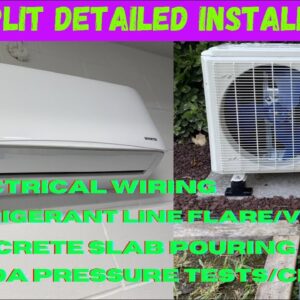DIY Installation of a Mini Split Air Conditioner: A Detailed Walkthrough for Your Home Garage
Introduction
Hey guys, welcome back to another home improvement adventure! Recently, many of you have followed my journey with various house and garage projects. Living in Florida poses unique challenges, especially the unrelenting heat in my garage. The sweltering conditions often deter my motivation to finish projects. So today, I’m going to tackle this issue head-on by installing a mini split air conditioner to keep my workspace comfortable all year long. Buckle up and get ready for a detailed walkthrough of this significant DIY project!
Planning and Preparation
Selecting the Right Unit
In choosing a unit for my garage (approximately 850 square feet), I opted for a one-ton (12,000 BTU) Pioneer mini split system, which I found to be reasonably priced at around $700-$800 on Amazon. The Pioneer brand is distributed by Parker Davis, an established HVAC company since the 1990s. It offers strong performance and reliability, making it an ideal choice for ensuring comfort through hot Florida summers.
Gathering the Necessary Tools and Supplies
Before diving into the installation, it’s essential to gather all the necessary tools and materials. Here’s what you’ll need:
- Mini Split System: Indoor and outdoor units, line sets, and a remote control.
- Vacuum Pump: Necessary for vacuuming the line before releasing refrigerant.
- Hole Saw: Diamond bits for drilling through a CMU (concrete masonry unit) brick wall.
- Wiring Supplies: A whip for the connection between the outdoor unit and the junction box, a suitable disconnect switch, and various electrical connectors.
- Gauge Set: For checking pressures and proper operation of the HVAC unit.
- Line Covers: To protect and organize the refrigerant lines.
- Miscellaneous Items: Grommets, anchors, tape, flare kit, silicone, and concrete mix (for making a pad).
Having everything at hand significantly speeds up the process and minimizes trips to the store.
Installation Steps
1. Unboxing the Mini Split System
Start by carefully unboxing all components. Ensure that each part – from the indoor unit to the line sets and remote control – is in good condition. Lay everything out on a table for easy access.
2. Check and Prepare Line Sets
Inspect the flares on the copper lines to ensure there are no burrs or damages which could lead to refrigerant leaks. I bought a flare kit from Harbor Freight to clean up these flares before installation. If the 16 feet of line set provided is too long, trim it down and re-flare as needed.
3. Electrical Setup
For the power connection, I tapped into an existing GFI outlet in my garage. Given the CMU brick wall, I decided to install a new dual gang box alongside enhancing the power distribution by offering additional outlets.
Steps:
- Cut a Dual Gang Box Hole: Carefully measure and cut a hole in the CMU wall, ensuring to avoid any wiring conduits that run inside the block.
- Wire the New Outlet: Using 14/2 Romex wire, connect the new outlets to the GFI circuit, ensuring proper protection and adherence to electrical codes.
4. Mounting Indoor Unit Bracket
Mount the bracket on the chosen spot on the wall. Ensure the mounting position follows the manufacturer’s recommendations, which typically require about six inches of clearance from the top and sufficient space on the sides. Use appropriate anchors to secure the bracket firmly.
5. Drilling the Hole for Line Set
Using a diamond bit hole saw, carefully drill a three-inch hole through the CMU wall for the refrigerant line, electrical connection, and condensate drain line. Make sure to drill at a slight downward angle to ensure proper drainage.
6. Preparing Indoor Unit Connections
Bend the copper lines out of the indoor unit and feed them, along with the electrical wire and drain line, through the wall hole. Attach the provided grommet to protect the lines from rough edges.
7. Mounting the Indoor Unit
Carefully hang the indoor unit on the bracket, ensuring all connections are protruding through the wall. Secure the IDU firmly to the bracket.
8. Outdoor Unit Placement and Pad Preparation
Clear a spot for the outdoor unit and prepare a concrete pad. I decided on a three-foot by 16-inch pad. Here’s how:
- Frame the Area: Use scrap 2x4s to create a frame.
- Dig a Hole: About an inch and a half deep to recess the frame.
- Lay Gravel: This improves drainage.
- Pour Concrete: Mix and pour concrete to form the pad. Use metal reinforcement for added strength.
After letting the pad set for two days, carefully bolt the outdoor unit onto the pad using rubber isolator feet which help dampen vibrations and elevate the unit slightly above ground level to prevent moisture damage.
9. Connecting Refrigerant Lines and Wiring
Refrigerant Lines:
- Connect and Seal: Attach the refrigerant lines using flare nut connections, applying a high-quality sealant like nylon blue for an airtight fit. Use appropriate wrenches to ensure correct torque without over-tightening.
Electrical Connections:
- Whips and Strain Reliefs: Use high-quality connectors and strain reliefs to secure the wiring from the indoor unit to the outdoor disconnect switch.
- Final Hookups: Match and connect the wires from the thermostat and power lines to their respective terminals, ensuring a secure and safe installation.
10. Vacuum and Leak Testing
With all connections in place, it’s time to vacuum the lines. Connect a gauge set and vacuum pump to the service port and run the pump for approximately 30 minutes, achieving a deep vacuum of around -30 inHg. Allow the system to sit for another 30 minutes to ensure the vacuum holds, indicating there are no leaks.
11. Releasing Refrigerant
Gradually release the refrigerant into the system through the valve, monitoring for any leaks. Once satisfied that there are no leaks, check the system pressures and temperatures to ensure they fall within operational specifications.
12. Final Checks and Cover Installation
Fit and secure all line covers, ensuring an aesthetic and protective finish for the refrigerant lines. Apply silicone around seams for a watertight fit.
13. System Testing
Fire up the system, test both cooling and heating modes, and measure the discharge temperatures and pressures. Ensure the system runs quietly and efficiently, demonstrating a successful installation.
Conclusion
After several days of diligent work, my garage is now a comfortable retreat, whether the Florida sun is blazing or the occasional cool breeze is blowing. This project took longer than expected due to family commitments and weather interruptions, but the rewarding cool air makes every effort worthwhile.
Key Takeaways
- Consistent Planning: Ensure you have all tools and supplies ready before starting.
- Attention to Detail: Carefully follow manufacturer instructions to avoid common pitfalls.
- Safety First: Always prioritize safety, especially when dealing with electrical components and refrigerants.
Remember, with perseverance and the right guidance, DIY projects become a manageable, rewarding endeavor. If I can do it, so can you!
Got questions about your own HVAC installation? Drop them in the comments. If you found this guide helpful, give it a thumbs up, and don’t forget to subscribe for more home improvement adventures!
Stay cool, everyone. Until next time!

